Introduces topics of forensic science including fingerprints, trace analysis, drug analysis, arson, explosives, serology, DNA, questioned documents, and bloodstain patterns. In addition, specific science topics will be addressed such as matter and properties, significant figures, chemical reactions, organic versus inorganic compounds, spectroscopy, mass spectrometry, chromatography, and electrophoresis.
This is an excellent and fun option for someone needing a science course. It is a wonderful alternative to traditional physical science, chemistry, physics, or biology courses. The student will learn some chemistry, physics, and biology; and then immediately see how the science is applied in the profession of forensic science. Although the course cannot replace the rigor of a traditional science course to develop a solid foundation for a student interested in becoming a scientist, it can serve as an introduction to science through forensic application. In addition, because many "advanced" science topics are introduced (i.e., chromatography, electrophoresis, spectroscopy, and mass spectrometry) it can also complement the studies of students greatly interested in science.
The course contains 40 lessons with each lesson having a video (~20 min), an accompanying PowerPoint file, worksheet, and review video. There are also 8 quizzes, a mid-term and final exam. In addition, 50+ short bonus videos are available showing physical evidence, techniques, and chemical instrumentation of the forensic scientist. This is a meager attempt to bring the laboratory to the student by making available videos I made years ago when I had access to a forensic laboratory.
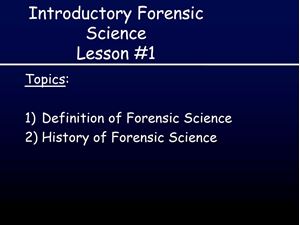
Definition and history of forensic science including major contributors to the develpment of forensic science.
Assignments:
- Review the PowerPoint file found in "Documents" tab for this lesson.
- Watch the video found in the "Video" tab for this lesson.
- Answer the worksheet questions found in the "Documents" tab for this lesson.
Definition and history of forensic science including major contributors to the develpment of forensic science.
Assignments:
- Watch the video found in the "Video" tab for this lesson to check your worksheet answers.
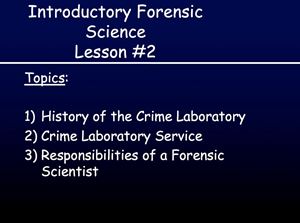
The history and organization of a crime laboratory.
Assignments:
- Review the PowerPoint file found in "Documents" tab for this lesson.
- Watch the video found in the "Video" tab for this lesson.
- Answer the worksheet questions found in the "Document" tab for this lesson.
The history and organization of a crime laboratory.
Assignments:
- Watch the video found in the "Video" tab for this lesson to check your worksheet answers.
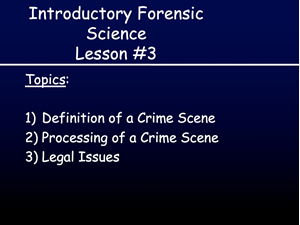
The definition, processing, and legal issues of a crime scene.
Assignments:
- Review the PowerPoint file found in "Documents" tab for this lesson.
- Watch the video found in the "Video" tab for this lesson.
- Answer the worksheet questions found in the "Documents" tab for this lesson.
The definition, processing, and legal issues of a crime scene.
Assignments:
- Watch the video found in the "Video" tab for this lesson to check your worksheet answers.
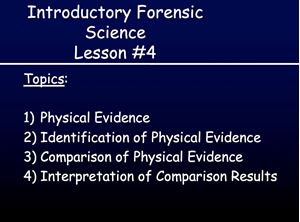
Physical evidence definition, identification, and comparison analyses.
Assignments:
- Review the PowerPoint file found in "Documents" tab for this lesson.
- Watch the video found in the "Video" tab for this lesson.
- Answer the worksheet questions found in the "Documents" tab for this lesson.
Physical evidence definition, identification, and comparison analyses.
Assignments:
- Watch the video found in the "Video" tab for this lesson to check your worksheet answers.
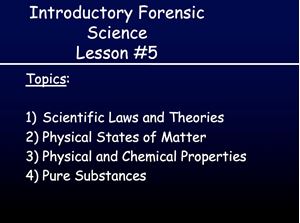
Lesson #5: Matter, mass, physical and chemical properties, elements, and compounds.
Assignments:
- Review the PowerPoint file found in "Documents" tab for this lesson.
- Watch the video found in the "Video" tab for this lesson.
- Answer the worksheet questions found in the "Documents" tab for this lesson.
Lesson #5: Matter, mass, physical and chemical properties, elements, and compounds.
Assignments:
- Watch the video found in the "Video" tab for this lesson to check your worksheet answers.
- Answer the 10 quiz questions from lectures 1-5 found in the "Tests" tab of this lesson.
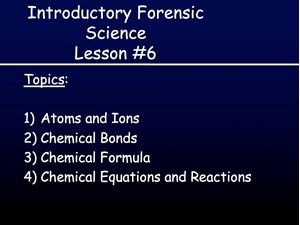
Introduces atoms, ions, chemical bonds, chemical formula, and chemical equations/reactions.
Assignments:
- Review the PowerPoint file found in "Documents" tab for this lesson.
- Watch the video found in the "Video" tab for this lesson.
- Answer the worksheet questions found in the "Documents" tab for this lesson.
Introduces atoms, ions, chemical bonds, chemical formula, and chemical equations/reactions.
Assignments:
- Watch the video found in the "Video" tab for this lesson to check your worksheet answers.
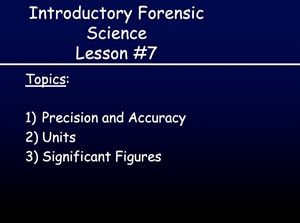
Lesson #7: Measurements, precision, accuracy, units, and significant figures.
Assignments:
- Review the PowerPoint file found in "Documents" tab for this lesson.
- Watch the video found in the "Video" tab for this lesson.
- Answer the worksheet questions found in the "Documents" tab for this lesson.
Lesson #7: Measurements, precision, accuracy, units, and significant figures.
Assignments:
- Watch the video found in the "Video" tab for this lesson to check your worksheet answers.
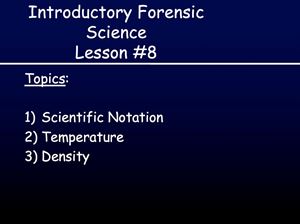
Lesson #8: Scientific notation, temperature, and density
Assignments:
- Review the PowerPoint file found in "Documents" tab for this lesson.
- Watch the video found in the "Video" tab for this lesson.
- Answer the worksheet questions found in the "Documents" tab for this lesson.
Lesson #8: Scientific notation, temperature, and density
Assignments:
- Watch the video found in the "Video" tab for this lesson to check your worksheet answers.
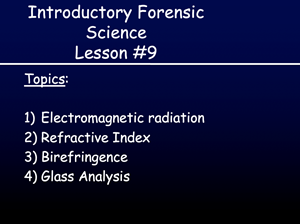
Lesson #9: An introductdion to forensic glass analysis including electromagnetic radiation, refractive index, birefringence, and glass analysis.
Assignments:
- Review the PowerPoint file found in "Documents" tab for this lesson.
- Watch the video found in the "Video" tab for this lesson.
- Watch the following videos in the "Resources" tab for the entire course.
- Glass Density Experiment
- Radial Fracture Direction of Impact
- Refractive Index of Glass is Greater
- Refractive Index of Solvent is Greater
- Answer the worksheet questions found in the "Documents" tab for this lesson.
A glass density experiment showing the differing densities of two glass samples. The more dense glass sample sinks in the liquid, and the less dense glass sample floats.
A short video showing a radial fracture with a direction of impact right to left due to the fracture lines forming right angles on the left side do the glass.
A short video showing the refractive index of glass is greater than the solvent due to the Becke line moving into the glass as the objective is moved away from the sample.
A short video showing the refractive index of the solvent is greater than the glass due to the Becke line moving into the solvent as the objective is moved away from the sample.
Lesson #9: An introductdion to forensic glass analysis including electromagnetic radiation, refractive index, birefringence, and glass analysis.
Assignments:
- Watch the video found in the "Video" tab for this lesson to check your worksheet answers.
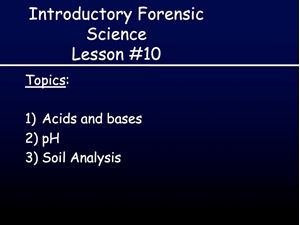
Lesson #10: An introduction to forensic soil analysis including a discussion of acids, bases, pH, and soil analysis techniques.
Assignments:
- Review the PowerPoint file found in "Documents" tab for this lesson.
- Watch the video found in the "Video" tab for this lesson.
- Watch the following video as part of this lesson.
- Soil Analysis Density Experiment
- Answer the worksheet questions found in the "Documents" tab for this lesson.
A short video showing the preparation of a density gradient with various solve mixtures. Two soil samples are compared in equivalent density gradients to determine density profiles.
Lesson #10: An introduction to forensic soil analysis including a discussion of acids, bases, pH, and soil analysis techniques.
Assignments:
- Watch the video found in the "Video" tab for this lesson to check your worksheet answers.
- Answer the 10 quiz questions from lectures 6-10 found in the "Tests" tab of this lesson.
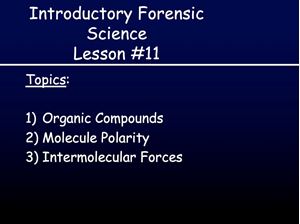
An introduction to organic compounds including molecular polarity and intermolecular forces.
Assignments:
- Review the PowerPoint file found in "Documents" tab for this lesson.
- Watch the video found in the "Video" tab for this lesson.
- Answer the worksheet questions found in the "Documentst" tab for this lesson.
An introduction to organic compounds including molecular polarity and intermolecular forces.
Assignments:
- Watch the video found in the "Video" tab for this lesson to check your worksheet answers.
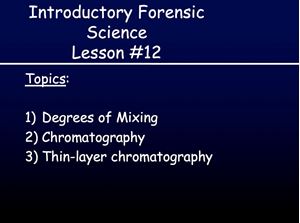
Lesson #12: A discussion of the degrees of mixing of two compounds as an introduction to the application of intermolecular forces in the process of chromatography. Thin layer chromatography is introduced.
Assignments:
- Review the PowerPoint file found in "Documents" tab for this lesson.
- Watch the video found in the "Video" tab for this lesson.
- Answer the worksheet questions found in the "Documents" tab for this lesson.
Lesson #12: A discussion of the degrees of mixing of two compounds as an introduction to the application of intermolecular forces in the process of chromatography. Thin layer chromatography is introduced.
Assignments:
- Watch the video found in the "Video" tab for this lesson to check your worksheet answers.
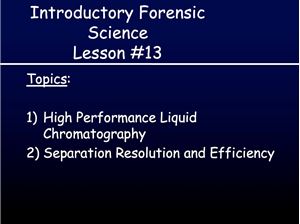
Lesson #13: An introduction to a specific separation technique called high performance liquid chromatography and associated separation resolution and efficiency.
Assignments:
- Review the PowerPoint file found in "Documents" tab for this lesson.
- Watch the video found in the "Video" tab for this lesson.
- Watch the following video as part of this lesson.
- Answer the worksheet questions found in the "Documents" tab for this lesson.
A short video showing someone operating a high performance liquid chromatograph (HPLC).
Lesson #13: An introduction to a specific separation technique called high performance liquid chromatography and associated separation resolution and efficiency.
Assignments:
- Watch the video found in the "Video" tab for this lesson to check your worksheet answers.
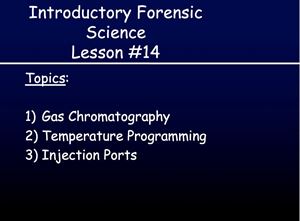
Lesson #14: An introduction to gas chromatography separation techniques including temperature programing and injection of sample.
Assignments:
- Review the PowerPoint file found in "Documents" tab for this lesson.
- Watch the video found in the "Video" tab for this lesson.
- Watch the following video as part of this lesson.
- Answer the worksheet questions found in the "Documents" tab for this lesson.
A short video showing someone operating a gas chromatograph instrument connected to a mass spectrometer.
Lesson #14: An introduction to gas chromatography separation techniques including temperature programing and injection of sample.
Assignments:
- Watch the video found in the "Video" tab for this lesson to check your worksheet answers.
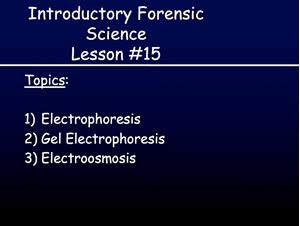
Lesson #15: An introduction to electrophoretic separation techniques including general electrophoresis, gel electrophoresis, and electroosmosis.
Assignments:
- Review the PowerPoint file found in "Documents" tab for this lesson.
- Watch the video found in the "Video" tab for this lesson.
- Answer the worksheet questions found in the "Documents" tab for this lesson.
Lesson #15: An introduction to electrophoretic separation techniques including general electrophoresis, gel electrophoresis, and electroosmosis.
Assignments:
- Watch the video found in the "Video" tab for this lesson to check your worksheet answers.
- Answer the 10 quiz questions from lectures 11-15 found in the "Tests" tab of this lesson.
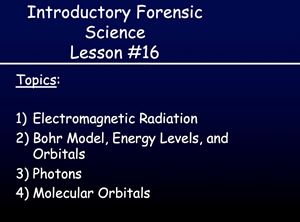
Lesson #16: A discussion of electromagnetic radiation, the Borh model of an atom, energy levels, atomic orbitals, photons, and molecular orbitals.
Assignments:
- Review the PowerPoint file found in "Documents" tab for this lesson.
- Watch the video found in the "Video" tab for this lesson.
- Answer the worksheet questions found in the "Documents" tab for this lesson.
Lesson #16: A discussion of electromagnetic radiation, the Borh model of an atom, energy levels, atomic orbitals, photons, and molecular orbitals.
Assignments:
- Watch the video found in the "Video" tab for this lesson to check worksheet answers.
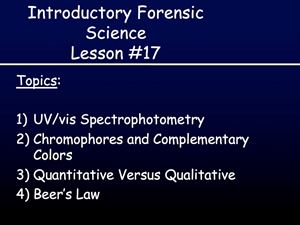
Lesson #17: An introduction to Uv-vis spectrophotometry including chromophores, complementary colors, quantitative analysis, qualitative analysis, and Beer's Law.
Assignments:
- Review the PowerPoint file found in "Documents" tab for this lesson.
- Watch the video found in the "Video" tab for this lesson.
- Watch the following video as part of this lesson.
- Answer the worksheet questions found in the "Documents" tab for this lesson.
A short video showing someone operating a UV-vis spectrophotometer.
Lesson #17: An introduction to Uv-vis spectrophotometry including chromophores, complementary colors, quantitative analysis, qualitative analysis, and Beer's Law.
Assignments:
- Watch the video found in the "Video" tab for this lesson to check your worksheet answers.
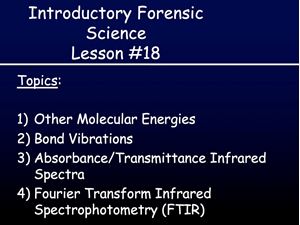
Lesson #18: An introductory discussion of molecular energies, chemical bond vibrations, infrared absorbance spectra, and Fourier transform infrared spectrophotometry.
Assignments:
- Review the PowerPoint file found in "Documents" tab for this lesson.
- Watch the video found in the "Video" tab for this lesson.
- Answer the worksheet questions found in the "Documents" tab for this lesson.
Lesson #18: An introductory discussion of molecular energies, chemical bond vibrations, infrared absorbance spectra, and Fourier transform infrared spectrophotometry.
Assignments:
- Watch the video found in the "Video" tab for this lesson to check your worksheet answers.
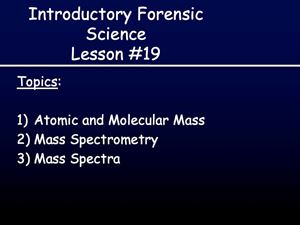
Lesson #19: An introduction to atomic and molecular mass units, basic mass spectrometry, and mass spectra for the purpose of compound identification.
Assignments:
- Review the PowerPoint file found in "Documents" tab for this lesson.
- Watch the video found in the "Video" tab for this lesson.
- Answer the worksheet questions found in the "Documents" tab for this lesson.
Lesson #19: An introduction to atomic and molecular mass units, basic mass spectrometry, and mass spectra for the purpose of compound identification.
Assignments:
- Watch the video found in the "Video" tab for this lesson to check your worksheet answers.
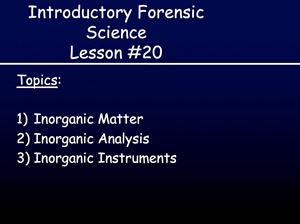
Lesson #20: Introduction to inorganic analysis including the classification of inorganic matter and the operation of inorganic instrumentation.
Assignments:
- Review the PowerPoint file found in "Documents" tab for this lesson.
- Watch the video found in the "Video" tab for this lesson.
- Watch the following video as part of this lesson.
- Answer the worksheet questions found in the "Documents" tab for this lesson.
A short video showing someone operating an atomic absorption spectrophotometer.
Lesson #20: Introduction to inorganic analysis including the classification of inorganic matter and the operation of inorganic instrumentation.
Assignments:
- Watch the video found in the "Video" tab for this lesson to check your worksheet answers.
- Answer the 10 quiz questions from lectures 16-20 found in the "Tests" tab of this lesson.
Mid-term exam containing 50 test questions from lessons 1-20.
Complete this exam to move onto lessons 21-40.
This exam should take you 30-60 minutes to complete.
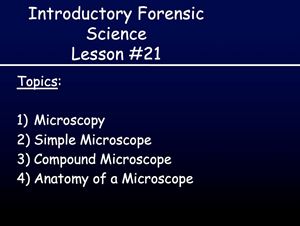
Lesson #21: An introduction to microscopy including the discussions of simple and compound microscopes, and the anatomy of a microscope.
Assignments:
- Review the PowerPoint file found in "Documents" tab for this lesson.
- Watch the video found in the "Video" tab for this lesson.
- Answer the worksheet questions found in the "Documents" tab for this lesson.
Lesson #21: An introduction to microscopy including the discussions of simple and compound microscopes, and the anatomy of a microscope.
Assignments:
- Watch the video found in the "Video" tab for this lesson to check worksheet answers.
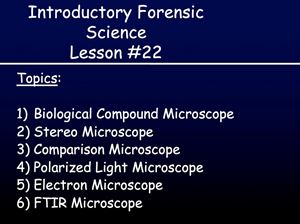
Lesson #22: A discussion of the compound, stereo, comparison, polarized light, and electron microscopes.
Assignments:
- Review the PowerPoint file found in "Documents" tab for this lesson.
- Watch the video found in the "Video" tab for this lesson.
- Watch the following videos as part of this lesson.
- Operation of a Stereomicroscope
- Operation of a Polarized Light Microscope
- Polarized Light Microscope Analysis of a Hair Sample
- Answer the workshet questions found in the "Documents" tab for this lesson.
A short video showing someone operating a stereomicroscope.
A short video showing someone operating a polarized light microscope for the analysis of a hair.
A short video showing the appearance of a hair sample under various settings of a polarized light microscope to determine optical properties.
Lesson #22: A discussion of the compound, stereo, comparison, polarized light, and electron microscopes.
Assignments:
- Watch the video found in the "Video" tab for this lesson to check your worksheet answers.
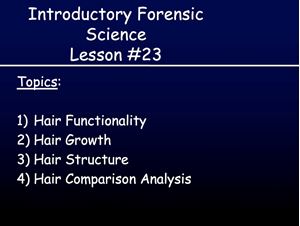
Lesson #23: An introduction to forensic hair analysis including a discussion of hair functionality, growth, structure, and comparisons.
Assignments:
- Review the PowerPoint file found in "Documents" tab for this lesson.
- Watch the video found in the "Video" tab for this lesson.
- Watch the following videos as part of this lesson.
- Bat Hair
- Cat Hair
- Cow Hair
- Dog Hair
- Goat Hair
- Horse Hair
- Human Hair I
- Human Hair II
- Human Hair III
- Muskrat Hair
- Pig Hair
- Rabbit Hair
- Rat Hair
- Sheep Hair
- Answer the worksheet questions found in the "Documents" tab for this lesson.
A short video showing the examination of bat hair with a biological compound microscope.
A short video showing the examination of cat hair with a biological compound microscope.
A short video showing the examination of cow hair with a biological compound microscope.
A short video showing the examination of dog hair with a biological compound microscope.
A short video showing the examination of goat hair with a biological compound microscope.
A short video showing the examination of horse hair with a biological compound microscope.
A short video showing the examination of human hair with a biological compound microscope.Notice the hair has very little medulla.
A short video showing the examination of human hair with a biological compound microscope.Notice the hair has a large amount of interrupted medulla.
A short video showing the examination of human hair with a biological compound microscope. Notice the hair has no medulla.
A short video showing the examination of muskrat hair with a biological compound microscope.
A short video showing the examination of pig hair with a biological compound microscope.
A short video showing the examination of rabbit hair with a biological compound microscope.
A short video showing the examination of rat hair with a biological compound microscope.
A short video showing the examination of sheep hair with a biological compound microscope.
Lesson #23: An introduction to forensic hair analysis including a discussion of hair functionality, growth, structure, and comparisons.
Assignments:
- Watch the video found in the "Video" tab for this lesson to check your worksheet answers.
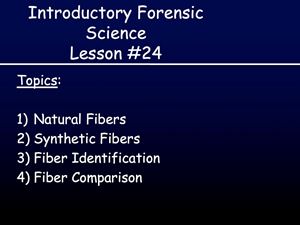
Lesson #24: Introduction to types of natural and synthetic fibers, and a discussion of fiber identification and comparison techniques.
Assignments:
- Review the PowerPoint file found in "Documents" tab for this lesson.
- Watch the video found in the "Video" tab for this lesson.
- Watch the following videos as part of this lesson.
- Acrylic Fibers
- Cotton Fibers
- Hemp Fibers
- Jute Fibers
- Linen Fibers
- Nylon Fibers
- Polyester Fibers
- Rayon Fibers
- Silk Fibers
- Answer the worksheet questions found in the "Documents" tab for this lesson.
A short video showing the examination of acrylic fibers with a biological compound microscope.
A short video showing the examination of cotton fibers with a biological compound microscope.
A short video showing the examination of hemp fibers with a biological compound microscope.
A short video showing the examination of jute fibers with a biological compound microscope.
A short video showing the examination of linen fibers with a biological compound microscope.
A short video showing the examination of nylon fibers with a biological compound microscope.
A short video showing the examination of polyester fibers with a biological compound microscope.
A short video showing the examination of rayon fibers with a biological compound microscope.
A short video showing the examination of silk fibers with a biological compound microscope.
Lesson #24: Introduction to types of natural and synthetic fibers, and a discussion of fiber identification and comparison techniques.
Assignments:
- Watch the video found in the "Video" tab for this lesson to check your worksheet answers.
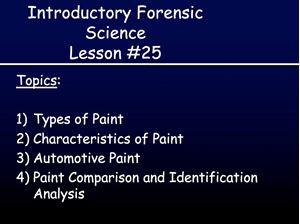
Lesson #25: Introduction to types of paint, paint characteristics, identification, and comparison techniques.
Assignments:
- Review the PowerPoint file found in "Documents" tab for this lesson.
- Watch the video found in the "Video" tab for this lesson.
- Answer the worksheet questions found in the "Documents" tab for this lesson.
Lesson #25: Introduction to types of paint, paint characteristics, identification, and comparison techniques.
Assignments:
- Watch the video found in the "Video" tab for this lesson to check your worksheet answers.
- Answer the 10 quiz questions from lectures 21-25 found in the "Tests" tab of this lesson.
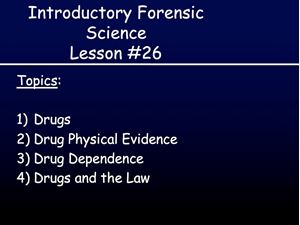
Lesson #26: An introduction to drugs, drug dependence, drugs as physical evidence, and drugs and the law.
Assignments:
- Review the PowerPoint file found in "Documents" tab for this lesson.
- Watch the video found in the "Video" tab for this lesson.
- Answer the worksheet questions found in the "Documents" tab for this lesson.
Lesson #26: An introduction to drugs, drug dependence, drugs as physical evidence, and drugs and the law.
Assignments:
- Watch the video found in the "Video" tab for this lesson to check your worksheet answers.
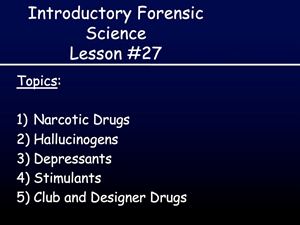
Lesson #27: In introduction to drug categories including narcotics, hallucinogens, depressants, stimulants, and designer drugs.
Assignments:
- Review the PowerPoint file found in "Documents" tab for this lesson.
- Watch the video found in the "Video" tab for this lesson.
- Answer the worksheet questions found in the "Documents" tab for this lesson.
Lesson #27: In introduction to drug categories including narcotics, hallucinogens, depressants, stimulants, and designer drugs.
Assignments:
- Watch the video found in the "Video" tab for this lesson to check your worksheet answers.
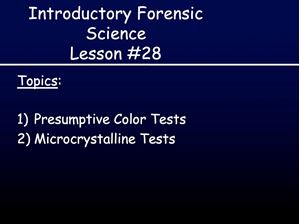
Lesson 28: An introduction to presumptive drug identification including several color and microcrystalline tests.
Assignments:
- Review the PowerPoint file found in "Documents" tab for this lesson.
- Watch the video found in the "Video" tab for this lesson.
- Watch the following videos as part of this lesson.
- Marijuana Cystolithic Hairs
- Marquis Test for Opiates
- Answer the worksheet questions found in the "Documents" tab for this lesson.
An examinations of marijuana leaves under a stereomicroscope showing the presence of cystolythic hairs.
A short video showing the use of the Marquis color test for the presumptive identification of an opiate. Notice the purple/violet color.
Lesson 28: An introduction to presumptive drug identification including several color and microcrystalline tests.
Assignments:
- Watch the video found in the "Video" tab for this lesson to check your worksheet answers.
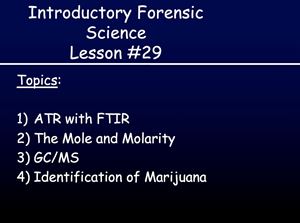
Lesson #29: Introduction to confirmatory drug identification including FTIR with ATR, GC/MS, identification of marijuana, and quantitative analysis.
Assignments:
- Review the PowerPoint file found in "Documents" tab for this lesson.
- Watch the video found in the "Video" tab for this lesson.
- Watch the following video as part of this lesson.
- Operation of an FTIR with an ATR
- Answer the worksheet questions found in the "Documents" tab for this lesson.
A short video showing someone operating an FTIR instrument with an ATR crystal.
Lesson #29: Introduction to confirmatory drug identification including FTIR with ATR, GC/MS, identification of marijuana, and quantitative analysis.
Assignments:
- Watch the video found in the "Video" tab for this lesson to check your worksheet answers.
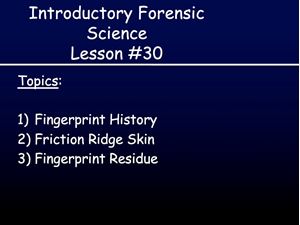
Lesson #30: An introduction to fingerprints including fingerprint identification history, friction ridge skin, and fingerprint residue.
Assignments:
- Review the PowerPoint file found in "Documents" tab for this lesson.
- Watch the video found in the "Video" tab for this lesson.
- Answer the worksheet questions found in the "Documents" tab for this lesson.
Lesson #30: An introduction to fingerprints including fingerprint identification history, friction ridge skin, and fingerprint residue.
Assignments:
- Watch the video found in the "Video" tab for this lesson to check your worksheet answers.
- Answer the 10 quiz questions from lectures 26-30 found in the "Tests" tab of this lesson.
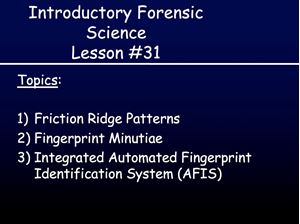
Lesson #31: Introduction to general fingerprint ridge patterns (arches, loops, and whorls), fingerprint minutiae, and the integrated automated fingerprint identification system.
Assignments:
- Review the PowerPoint file found in "Documents" tab for this lesson.
- Watch the video found in the "Video" tab for this lesson.
- Answer the worksheet questions found in the "Documents" tab for this lesson.
Lesson #31: Introduction to general fingerprint ridge patterns (arches, loops, and whorls), fingerprint minutiae, and the integrated automated fingerprint identification system.
Assignments:
- Watch the video found in the "Video" tab for this lesson to check your worksheet answers.
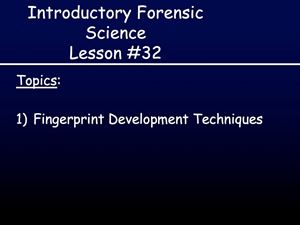
Lesson #32: An introduction to fingerprint development techniques including iodine fuming, ninhydrin, superglue fuming, dusting, and crystal violet.
Assignments:
- Review the PowerPoint file found in "Documents" tab for this lesson.
- Watch the video found in the "Video" tab for this lesson.
- Watch the following videos as part of this lesson.
- Crystal Violet Fingerprint Development
- Iodine Fuming Fingerprint Development
- Ninhydrin Fingerprint Development
- Superglue Fuming Fingerperint Development
- Answer the worksheet questions found in the "Documents" tab for this lesson.
A short video showing the development of finger prints using crystal violet.
A short video showing the development of fingerprints using iodine fuming.
A short video showing the development of fingerprints using ninhydrin.
A short video showing the development of fingerprints using superglue fuming.
Lesson #32: An introduction to fingerprint development techniques including iodine fuming, ninhydrin, superglue fuming, dusting, and crystal violet.
Assignments:
- Watch the video found in the "Video" tab for this lesson to check your worksheet answers.
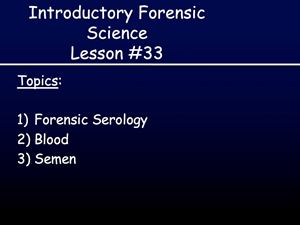
Lesson #33: An introduction to forensic serology including the analysis of blood and semen.
Assignments:
- Review the PowerPoint file found in "Documents" tab for this lesson.
- Watch the video found in the "Video" tab for this lesson.
- Watch the following videos as part of this lesson.
- Leucomalachite Green Blood Identificaiton
- ortho-Tolidine Blood Identification
- Red Blood Cells
- Dyed Sperm Cells
- Answer the worksheet questions found in the "Documents" tab for this lesson.
A short video showing the use of leucomalachite green for the identification of blood. Notice the appearance of the blue-green color.
A short video showing the use of ortho-tolidine for the purpose of a presumptive blood identification. Notice the appearance of the blue-green color.
A short video showing the appearance of red blood cells under a biological compound microscope.
A short video showing the appearance of dyed sperm cells under a biological compound microscope. Notice the heads of the sperm cells are dyed.
Lesson #33: An introduction to forensic serology including the analysis of blood and semen.
Assignments:
- Watch the video found in the "Video" tab for this lesson to check your worksheet answers.
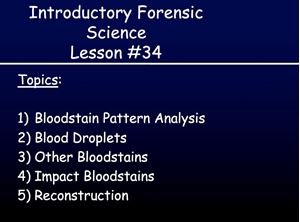
Lesson #34: An introduction to bloodstain pattern analysis including blood droplets, swipes, wipes, impact stains, and crime scene reconstruction.
Assignments:
- Review the PowerPoint file found in "Documents" tab for this lesson.
- Watch the video found in the "Video" tab for this lesson.
- Answer the worksheet questions found in the "Documents" tab for this lesson.
Lesson #34: An introduction to bloodstain pattern analysis including blood droplets, swipes, wipes, impact stains, and crime scene reconstruction.
Assignments:
- Watch the video found in the "Video" tab for this lesson to check your worksheet answers.
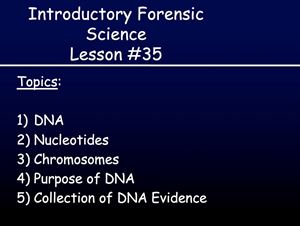
Lesson #35: An introduction to DNA including a discussion of nucleotides, chromosomes, the purpose of DNA, and DNA collection.
Assignments:
- Review the PowerPoint file found in "Documents" tab for this lesson.
- Watch the video found in the "Video" tab for this lesson.
- Answer the worksheet questions found in the "Documents" tab for this lesson.
Lesson #35: An introduction to DNA including a discussion of nucleotides, chromosomes, the purpose of DNA, and DNA collection.
Assignments:
- Watch the video found in the "Video" tab for this lesson to check your worksheet answers.
- Answer the 10 quiz questions from lectures 31-35 found in the "Tests" tab of this lesson.
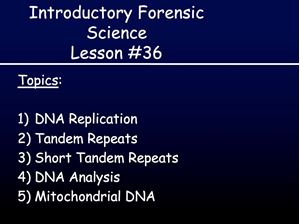
Lesson #36: An introduction to DNA analysis including DNA replication, PCR, tandem repeats, RFLP, short tandem repeats, and mitochondrial DNA.
Assignments:
- Review the PowerPoint file found in "Documents" tab for this lesson.
- Watch the video found in the "Video" tab for this lesson.
- Answer the worksheet questions found in the "Documents" tab for this lesson.
Lesson #36: An introduction to DNA analysis including DNA replication, PCR, tandem repeats, RFLP, short tandem repeats, and mitochondrial DNA.
Assignments:
- Watch the video found in the "Video" tab for this lesson to check your worksheet answers.
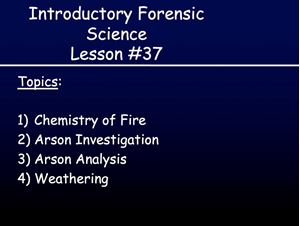
Lesson #37: An introduction to forensic arson investigation including the chemistry of fire, arson evidence collection, arson evidence analysis, and weathering.
Assignments:
- Review the PowerPoint file found in "Documents" tab for this lesson.
- Watch the video found in the "Video" tab for this lesson.
- Answer the worksheet questions found in the "Documents" tab for this lesson.
Lesson #37: An introduction to forensic arson investigation including the chemistry of fire, arson evidence collection, arson evidence analysis, and weathering.
Assignments:
- Watch the video found in the "Video" tab for this lesson to check your worksheet answers.
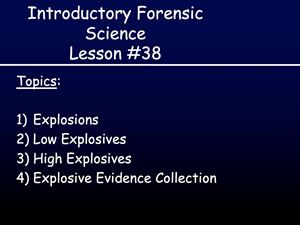
Lesson #38: An introduction to explosives including a discussing low explosives, high explosives, and explosive evidence collection.
Assignments:
- Review the PowerPoint file found in "Documents" tab for this lesson.
- Watch the video found in the "Video" tab for this lesson.
- Answer the worksheet questions found in the "Documents" tab for this lesson.
Lesson #38: An introduction to explosives including a discussing low explosives, high explosives, and explosive evidence collection.
Assignments:
- Watch the video found in the "Video" tab for this lesson to check your worksheet questions.
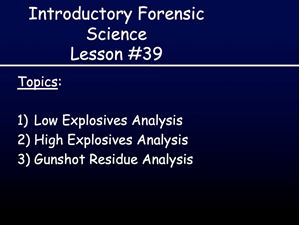
Lesson #39: An introduction to the forensic analysis of explosives including analysis techniques for low explosives, high explosives, and gunshot residue.
Assignments:
- Review the PowerPoint file found in "Documents" tab for this lesson.
- Watch the video found in the "Video" tab for this lesson.
- Watch the following videos as part of this lesson.
- Nitrate Color Test
- Carbon Flame Test
- Lead Color Test
- Nitrite Color Test
- Nitrocellulose Precipitate Test
- Potassium Flame Test
- TNT Color Test
- Answer the worksheet questions found in the "Documents" tab for this lesson.
A short video showing the use of diphenylphenol for the determination of nitrate presence.
A short video showing the presence of carbon due to the smoldering of the suspect carbon material on the end of a metal spatula after being placed in a flame.
A short video showing the use of sodium rhodizonate to identify the presence of lead.
A short video showing the use of the Griess test to identify the presence of nitirites.
A short video showing the precipitate of nitrocellulose in water.
A short video showing the presence of potassium as indicated by the violet flame.
A short video showing the use of potassium hydroxide in methanol for the presumptive identification of TNT. Notice the appearance of the red/orange color.
Lesson #39: An introduction to the forensic analysis of explosives including analysis techniques for low explosives, high explosives, and gunshot residue.
Assignments:
- Watch the video found in the "Video" tab for this lesson to check your worksheet answers.
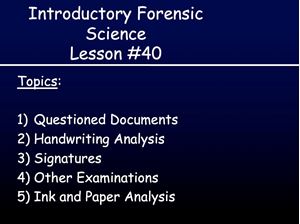
Lesson #40: An introduction to questioned document analysis including handwriting, signatures, obliterations, ink, and paper analysis.
Assignments:
- Review the PowerPoint file found in "Documents" tab for this lesson.
- Watch the video found in the "Video" tab for this lesson.
- Answer the worksheet questions found in the "Documents" tab for this lesson.
Lesson #40: An introduction to questioned document analysis including handwriting, signatures, obliterations, ink, and paper analysis.
Assignments:
- Watch the video found in the "Video" tab for this lesson to check your worksheet answers.
- Answer the 10 quiz questions from lectures 36-40 found in the "Tests" tab of this lesson.
Final exam containing 50 test questions from lessons 21-40.
This exam should take you 30-60 minutes to complete.
